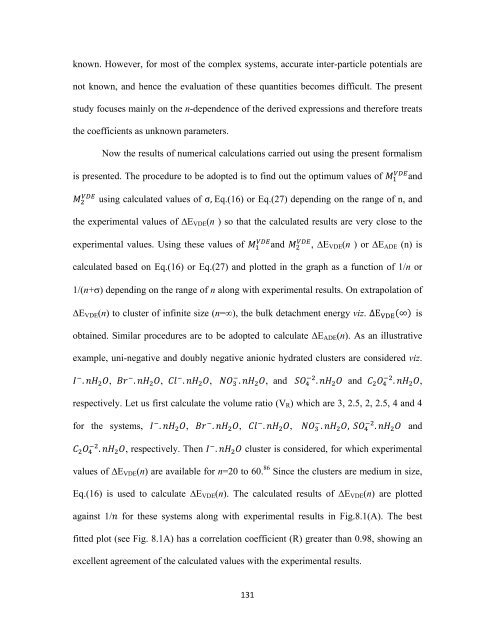CHEM01200604005 A. K. Pathak - Homi Bhabha National Institute
CHEM01200604005 A. K. Pathak - Homi Bhabha National Institute
CHEM01200604005 A. K. Pathak - Homi Bhabha National Institute
You also want an ePaper? Increase the reach of your titles
YUMPU automatically turns print PDFs into web optimized ePapers that Google loves.
known. However, for most of the complex systems, accurate inter-particle potentials are<br />
not known, and hence the evaluation of these quantities becomes difficult. The present<br />
study focuses mainly on the n-dependence of the derived expressions and therefore treats<br />
the coefficients as unknown parameters.<br />
Now the results of numerical calculations carried out using the present formalism<br />
is presented. The procedure to be adopted is to find out the optimum values of and<br />
<br />
using calculated values of σ, Eq.(16) or Eq.(27) depending on the range of n, and<br />
the experimental values of ∆E VDE (n ) so that the calculated results are very close to the<br />
experimental values. Using these values of and , ∆E VDE (n ) or ∆E ADE (n) is<br />
calculated based on Eq.(16) or Eq.(27) and plotted in the graph as a function of 1/n or<br />
1/(n+σ) depending on the range of n along with experimental results. On extrapolation of<br />
∆E VDE (n) to cluster of infinite size (n=∞), the bulk detachment energy viz. ∆E DE ∞ is<br />
obtained. Similar procedures are to be adopted to calculate ∆E ADE (n). As an illustrative<br />
example, uni-negative and doubly negative anionic hydrated clusters are considered viz.<br />
. , . , . , . , and . and . ,<br />
respectively. Let us first calculate the volume ratio (V R ) which are 3, 2.5, 2, 2.5, 4 and 4<br />
for the systems, . , . , . , . , . and<br />
. , respectively. Then . cluster is considered, for which experimental<br />
values of ∆E VDE (n) are available for n=20 to 60. 86 Since the clusters are medium in size,<br />
Eq.(16) is used to calculate ∆E VDE (n). The calculated results of ∆E VDE (n) are plotted<br />
against 1/ for these systems along with experimental results in Fig.8.1(A). The best<br />
fitted plot (see Fig. 8.1A) has a correlation coefficient (R) greater than 0.98, showing an<br />
excellent agreement of the calculated values with the experimental results.<br />
131
















